Freshly baked pear and ginger scones are one of my favourite fruit scones. Never a fan of dried fruit in scones, I like to use fresh fruit, enhancing the flavour of sweet conference pears with ground ginger and a touch of nutmeg.
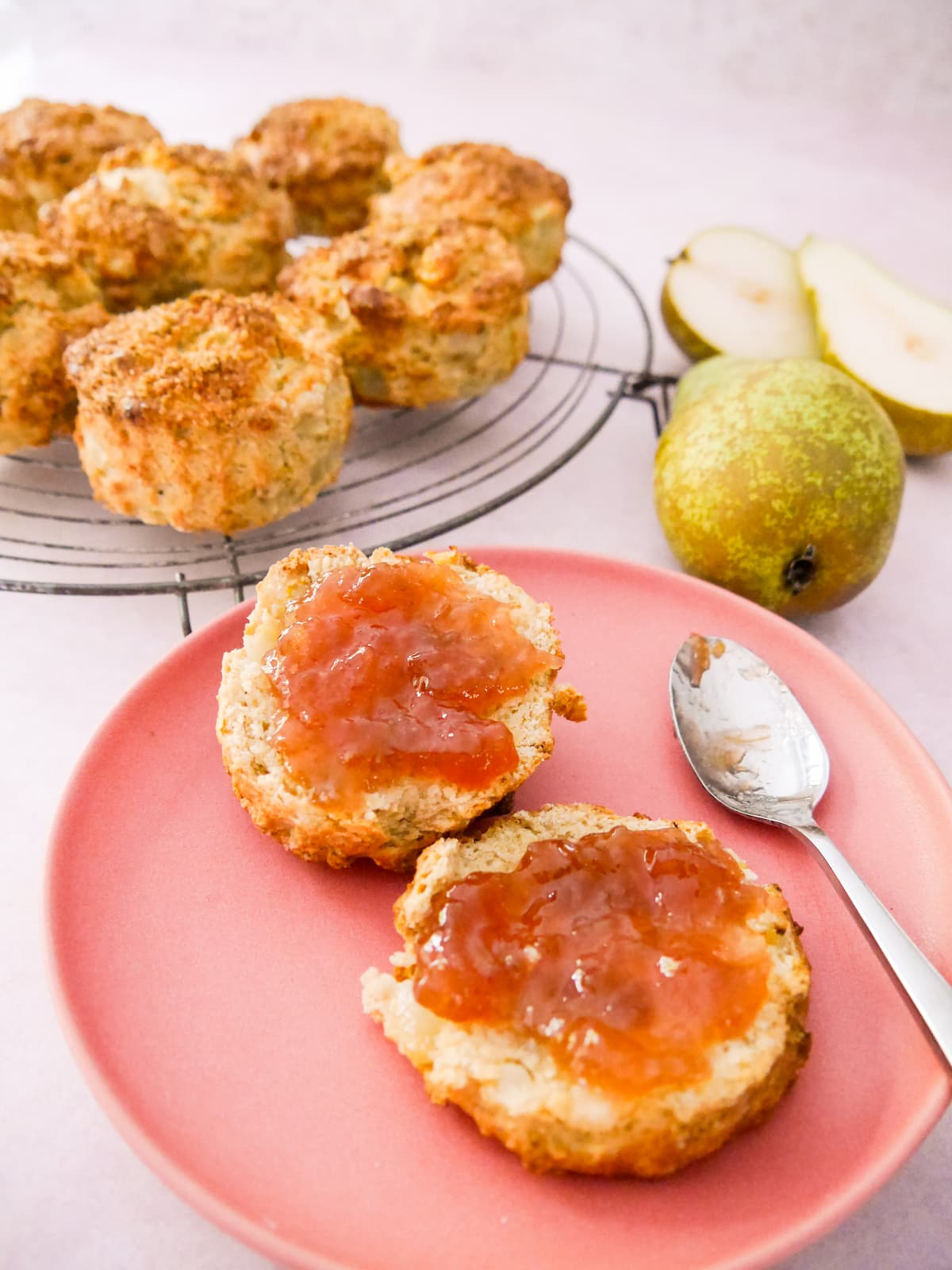
To make these pear and ginger buttermilk scones I've used my basic Buttermilk Scone recipe as a base, adding diced pear, ground ginger and nutmeg to the scone dough. I sprinkled some ginger sugar over the scones, just before baking, to really enhance the flavour of ginger.
Easy pear and ginger scones are a treat any time of the day, enjoy them fresh from the oven with salted butter and your favourite jam.
I bake a good scone however, I have friends who say that they struggle to bake a decent scone. Some complain about the lack of rise, others saying they are too tough.
Scone dough needs a light hand. As with all scones it is essential not to overwork the dough mixture! Most of the problems people tell me about when they are baking scones are the result of too heavy a hand and overworking the dough.
Within this recipe post I will explain the process and give you my top tips for baking the perfect scone!
Why you'll love this recipe
- A change from a plain scone, the combination of pear and ginger is delicious and something a little different.
- Scones are a quick bake, once prepared they take very little time to bake and can be enjoyed warm, straight from the oven!
- Feed a crowd as this recipe can be easily doubled up.
Recipe ingredients
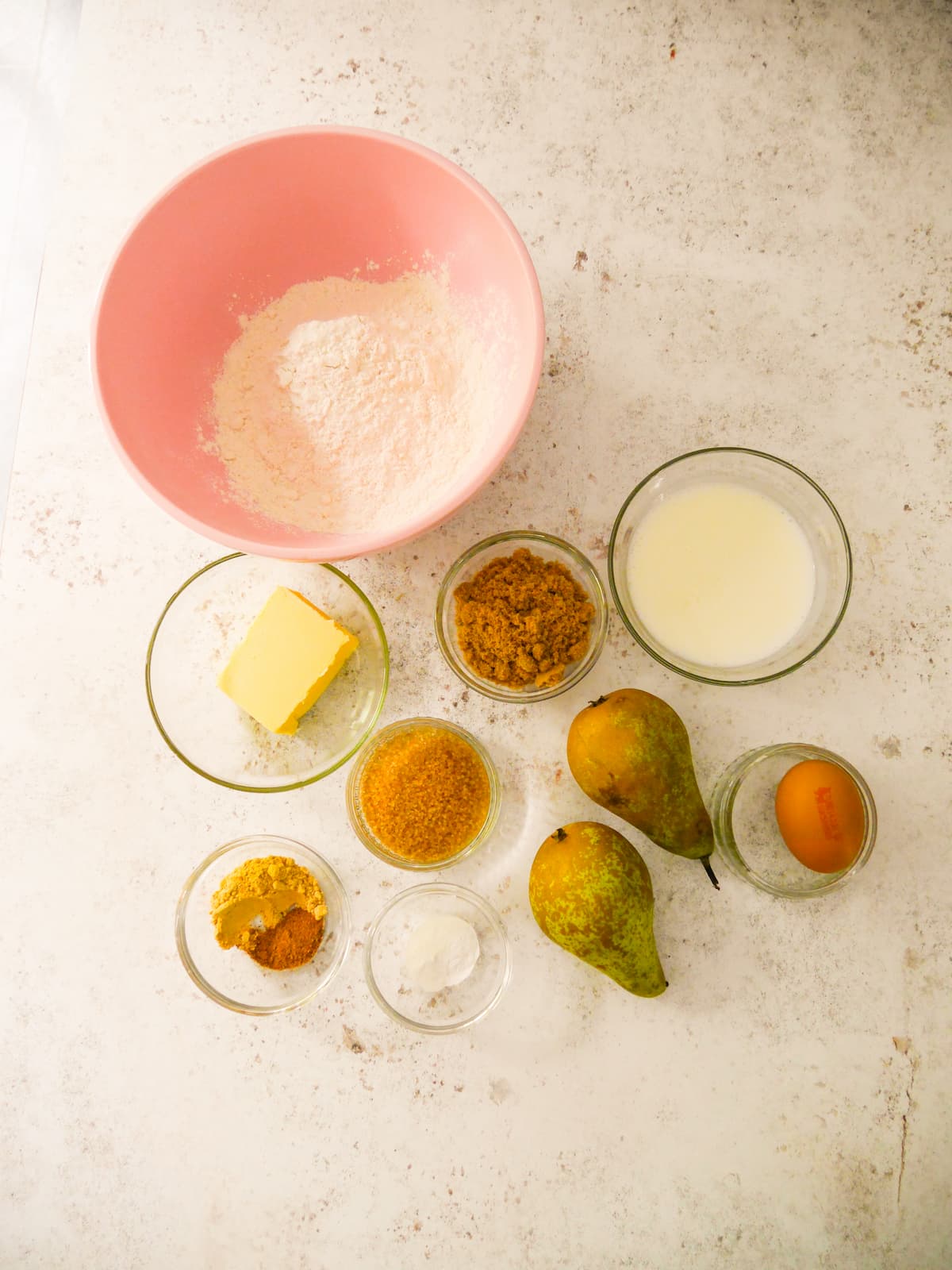
- Flour - I use self raising flour to make the scones, with a little extra for dusting my work surface.
- Sugar - I like to use light muscovado or soft light brown sugar to make fruit scones as it adds an extra depth of flavour. I also like to mix some demerara sugar with ground ginger to sprinkle over the top of the scone before baking.
- Baking powder - I add ½ teaspoon of baking powder when baking scones with added fruit, this helps give the scones a little extra rise.
- Salt - I always add a pinch of salt which helps balance out the sweetness.
- Spices - I use ground ginger and nutmeg in the scone dough. Also a little extra ginger to dust over the top of the scone before baking.
- Butter - when baking scones I use unsalted butter. If using salted butter leave out the pinch of salt in the dry ingredients.
- Egg - I use a large free range egg to make the scone dough, plus an extra egg to brush over and glaze the scone before baking.
- Buttermilk - I like to use buttermilk when baking scones as I think it results is a better, more tender scone.
- Pears - I've used conference pears as I like the flavour, but any variety will work. Look semi-firm pears as you want to be able to dice them. Too hard they've no flavour and too soft they're unmanageable and wet. I add 250g of diced pear, which is roughly 2 medium pears, once they've been peeled and cored.
How to make pear & ginger scones

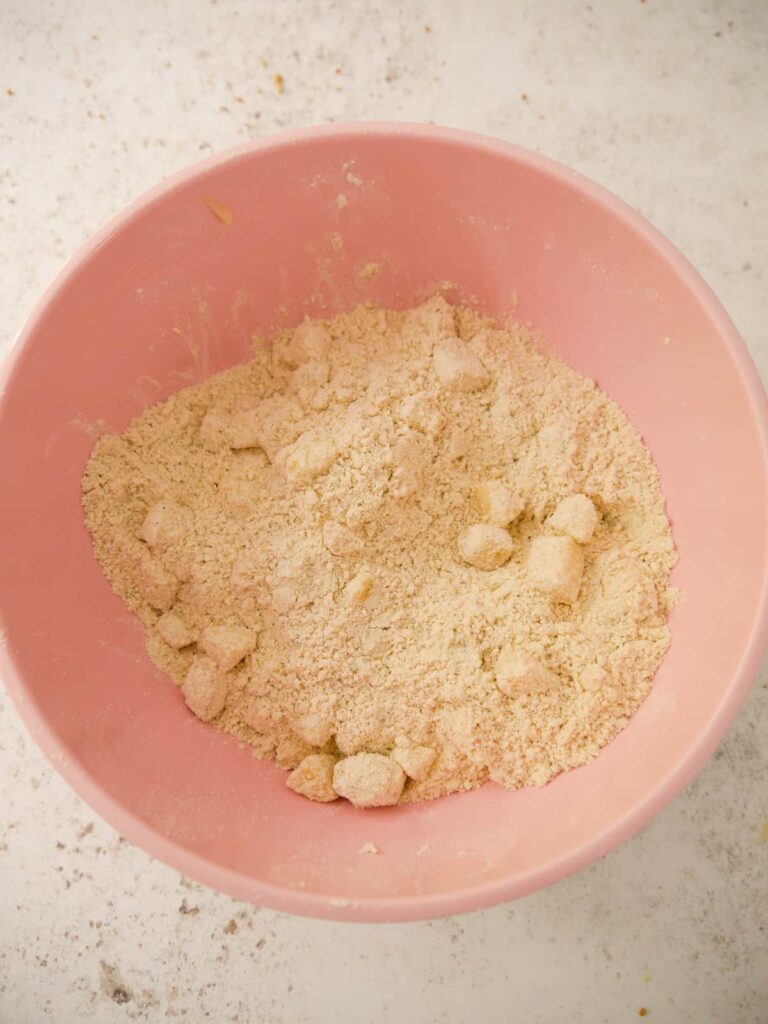
- Preheat the oven to 220°C/200°CFan/390F. Line a baking sheet with a silicone mat or baking parchment.
- Place the flour, light brown sugar, baking powder and salt into a mixing bowl. Add 1.5 teaspoon of the ground ginger and all of the nutmeg.
- Now add the butter and rub it into the flour mixture with your fingers until it resembles fine breadcrumbs. Work quickly as you don't want the butter to warm up and melt.
- Peel, core and dice the pears small, add to the flour mixture and stir through, ensuring all the pear pieces are separated and covered in flour.


- In a measuring jug, mix the egg with the buttermilk.
- Add the egg mixture into the dry ingredients and mix gently with a fork, just enough to bring the mixture together into a dough. DO NOT OVERMIX OR KNEAD THE DOUGH!
- Turn the dough out onto a well floured work surface and gently pat down to 2.5cm (1").
- Cut the scones with a scone cutter or knife to the desired shape and size. Cut the first round of scones then gently bring the leftover dough together again before cutting more scones.


- Place the scones onto the baking sheet and brush the top of each scone with egg wash or milk.
- Place the demerara sugar into a small bowl and stir through the remaining ½ teaspoon of ground ginger. Sprinkle a little of the ginger sugar over the top of each scone.
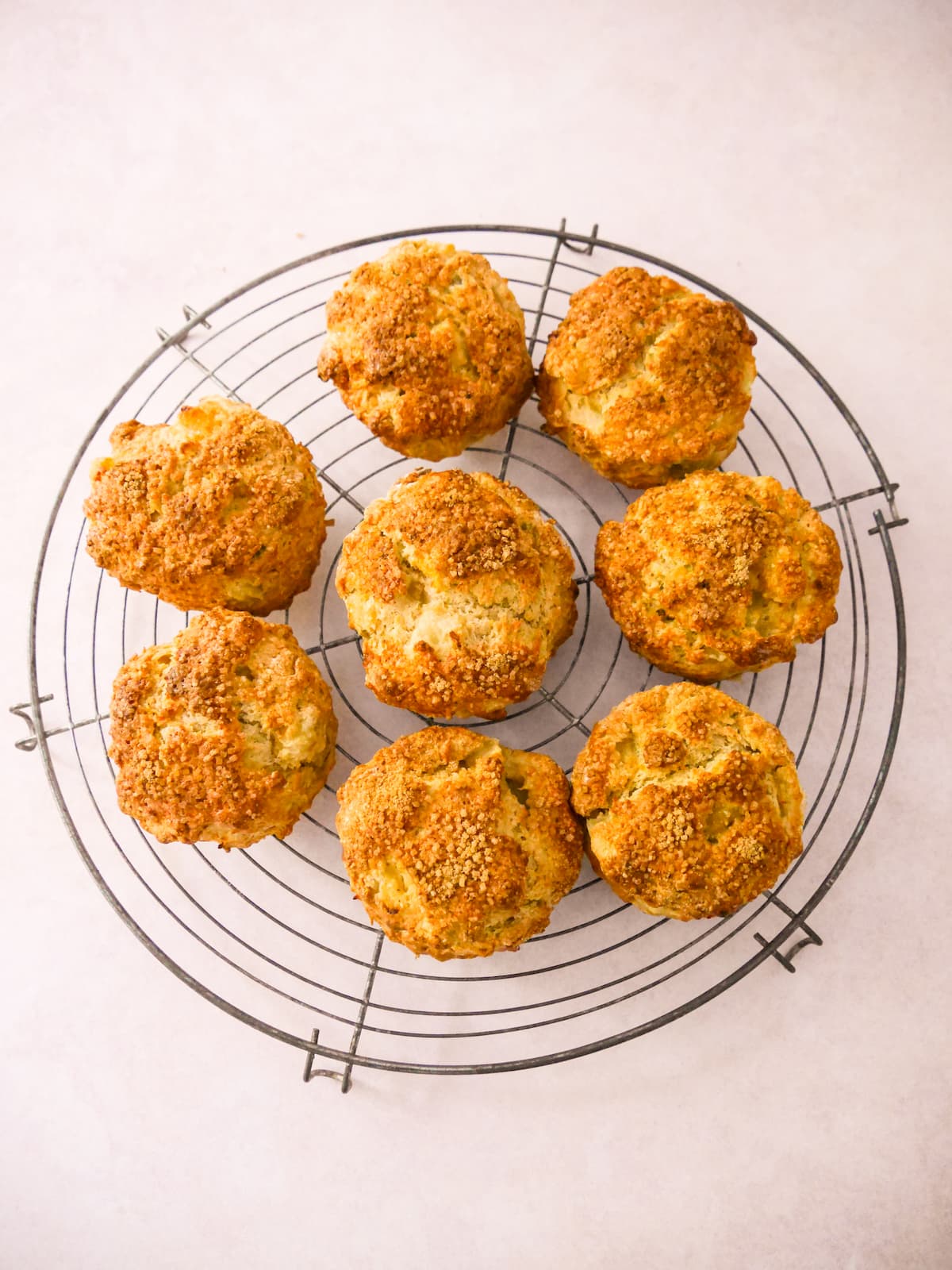
- Place the scones into a warm oven and bake for 14-18 minutes until golden. Note that cooking times will vary depending on the size of the scone cutter used. I used a 6cm (2 ½ inch) scone cutter.
- Remove the scones from the oven and place on a wire rack to cool for 5-10 minutes before serving.
What is the secret to making good scones?
There are a few basic rules that you need to follow if you want to bake light and fluffy scone.
- When rubbing the butter into the dry ingredients, use the tips of your fingers to form a breadcrumb like consistency and work quickly to keep the butter cool. If you use your whole hand it will warm up the butter and melt it, leaving you with something unworkable.
- When bringing the dough together I like to use a fork, or sometimes just my fingers. Take care not to be too heavy handed, you're only trying to pull the ingredients together into a rough ball.
- Once combined into a rough ball, place on a very well floured surface to stop the dough from sticking. Gently press down until the dough is 2.5cm/1" in depth. I prefer to do this rather than using a rolling pin which can flatten the scones too much. If using a rolling pin add a generous amount of flour to that too.
- Do not knead the dough! If you overwork the dough it will not rise, you will be left with flat, hard scones. The less you work the dough the better the rise and the fluffier the scone.
- Cut the first round of scones then gently bring the leftover dough together again before cutting more scones.
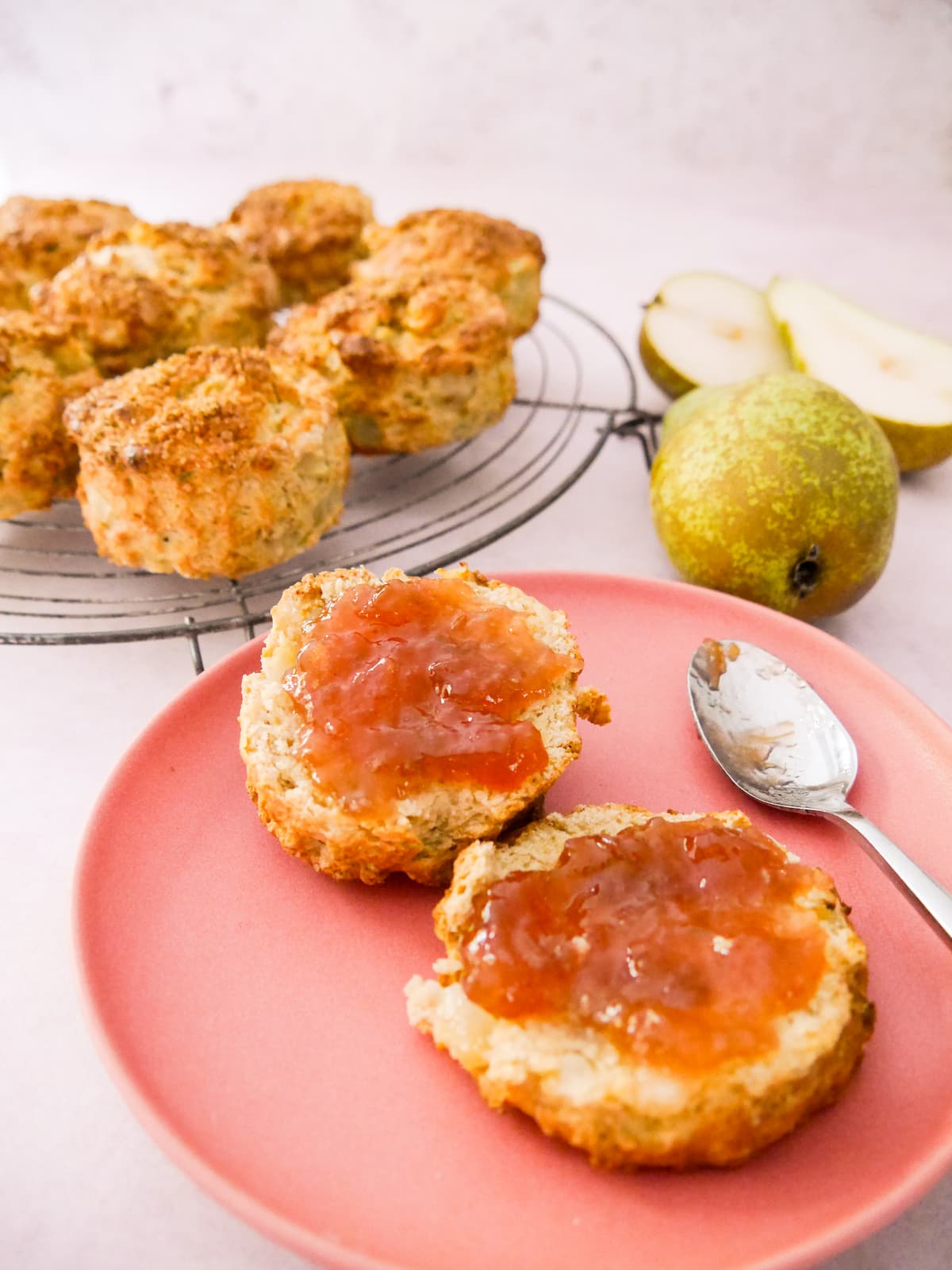
Recipe variations
- I like to use buttermilk in scones as it has a nice acidity which balances the sweetness. You could swap the buttermilk for whole milk if you prefer.
- I've added ground ginger and nutmeg to the scone dough, but feel free to swap for other spices, like ground cinnamon or a pinch of clove. If you prefer, or leave out the spice altogether.
- I like to sprinkle some ginger spice sugar over the top of the scone before baking, but this is entirely optional.
- I love the flavour of ginger and if you want to really intensify the flavour you could add the finely grated zest of a piece of stem ginger, removing as much of the syrup from the outside to stop the scones becoming wet. Add the stem ginger along with the diced pear.
Serving suggestions
When it comes to pear and ginger buttermilk scones I love slather them with butter and spread with homemade jam. I've opted for my homemade Rhubarb & Ginger Jam, to really intensify the flavour of ginger. I also like these scones with my homemade Apple Jelly, Blackberry Jelly (Bramble Jelly), or Blackcurrant Jelly if I have a jar.
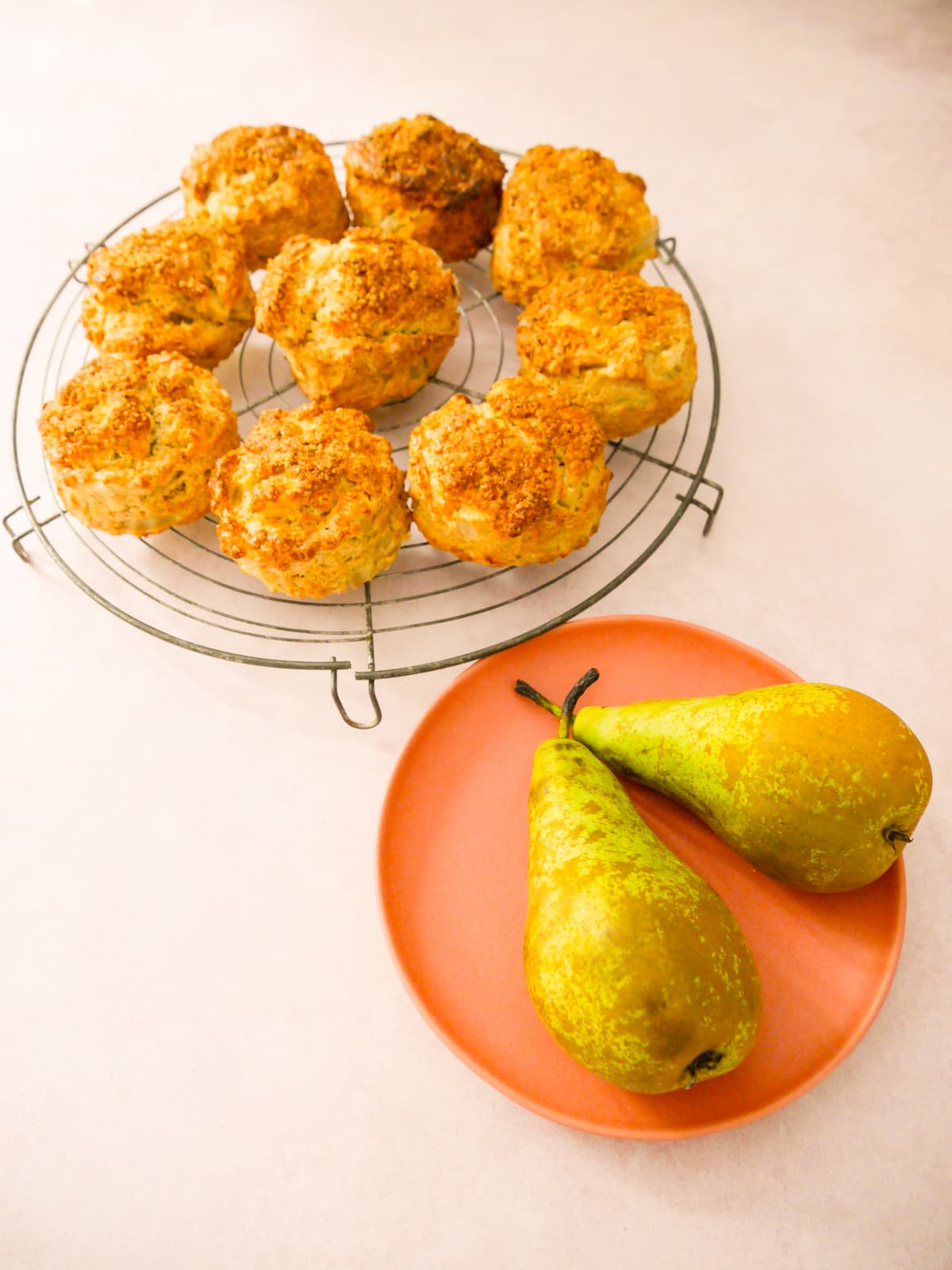
Useful hints and tips
- Buttermilk: buttermilk in the UK is quite thick, if you are using milk, you may need to reduce the quantity.
- Adapt baking times: baking times will vary depending on your oven, and also the size of the scone cutter used.
- Equipment: If you don't have a scone cutter, use the bottom of a glass or cup to shape the scones. Alternatively use a sharp knife to cut the scones.
- Allergy advice: soya free and nut free. For comprehensive and detailed allergy advice go to Allergy UK.
FAQs
When flavouring scones with anything that might weigh them down (eg fruit, cheese, etc) I like to add a little baking powder to the scone mix to help the dough to rise. However, do not be heavy handed with the baking powder add only the ½ teaspoon asked for in the recipe. Anything more will result in a scone that tastes terrible. Add just enough to get the scones to lift.
I am firmly of the opinion that scones are best eaten when warm and fresh from the oven, the day they are baked. They will keep another day, stored in an airtight container, but past 2 days the start to taste a bit stale. A quick heat up in the microwave or oven does help soften them.
Yes, scones freeze really well, so you can take out and enjoy at a later date. When freezing scones, simply allow to them to cool completely and place into and airtight container suitable for the freezer. When taking your scones back out of the freezer they are best when warmed up a little in the oven before serving.
Pin the recipe
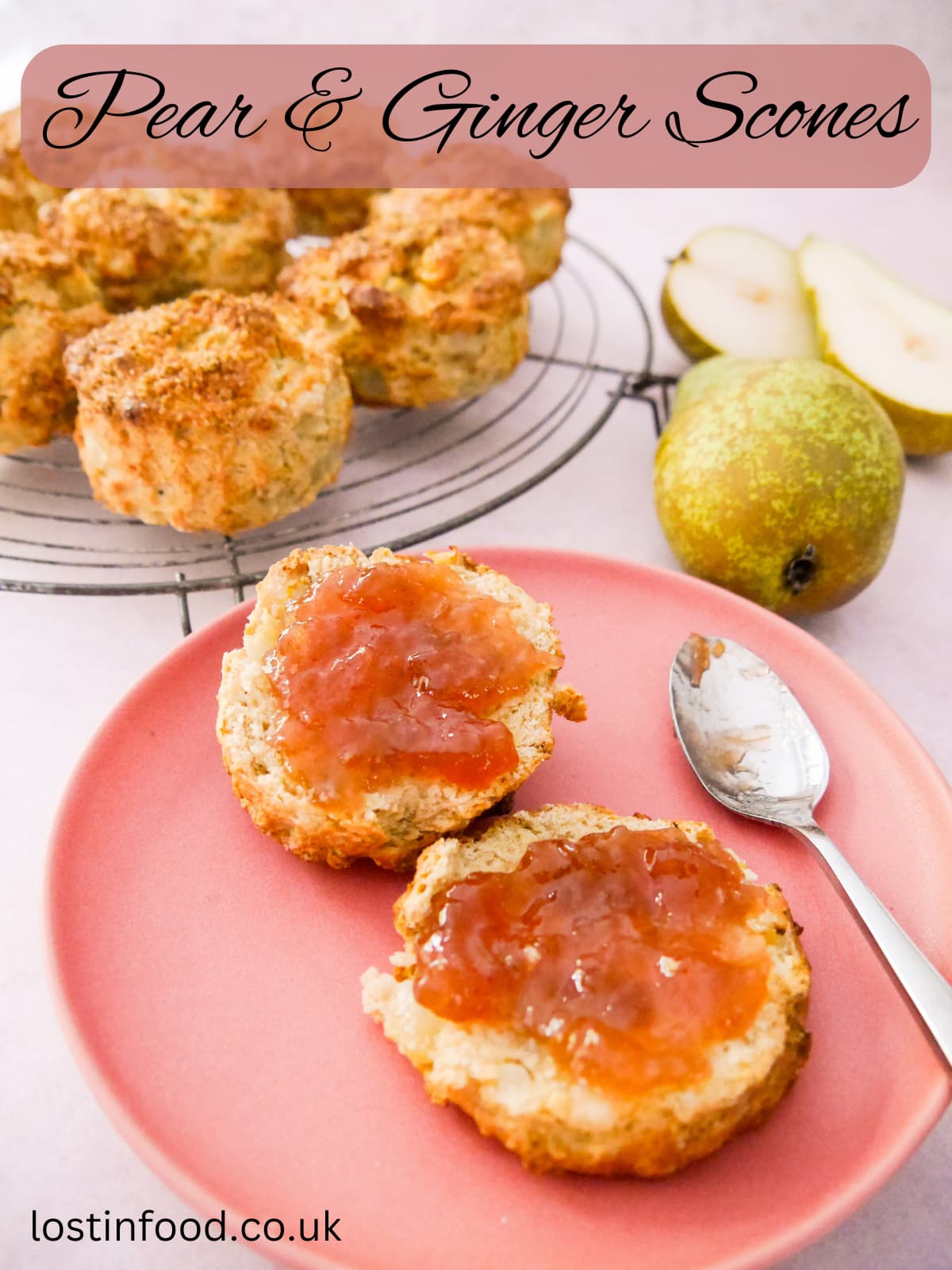
Additional recipe suggestions
If you like this recipe then try some of my other scone and easy bake recipes:
- Buttermilk Scone
- Lemon Blueberry Scones
- Apple & Cinnamon Scone
- Pumpkin Spiced Scone
- Savoury Cheese Scones
- Spiced Apple Cake
- Eve's Pudding
- Traditional Rock Cakes (also known as Rock Buns)
If you enjoyed this bake have a look at my Fun Baking with Kids post. This guide is full of great recipe suggestions, hints and tips for anyone who enjoys baking.
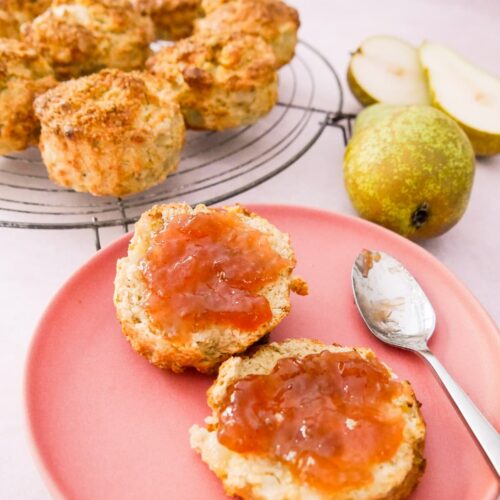
Pear & Ginger Scones
Equipment
- large mixing bowl
- weighing scales
- Measuring jug
- measuring spoons
- Fork
- Scone/cookie cutter
- Baking sheet
- Silicone liner or baking parchment
Ingredients
- 300 g self raising flour (plus extra for dusting worksurface)
- 50 g soft light brown sugar
- ½ teaspoon baking powder
- 1 pinch salt
- 2 teaspoon ground ginger (divided)
- ½ teaspoon freshly grated nutmeg
- 50 g unsalted butter
- 1 large free range egg (plus extra egg, beaten to make an egg glaze to pain over the scone before baking)
- 100 ml buttermilk
- 250 g pear (diced small, from 2 conference pears, or similar)
- 1 tablespoon demerara sugar
Instructions
- Preheat the oven to 220°C/200°CFan/390F. Line a baking sheet with a silicone mat or baking parchment.
- Place the flour, light brown sugar, baking powder and salt into a mixing bowl. Add 1.5 teaspoon of the ground ginger and all of the nutmeg.
- Now add the butter and rub it into the flour mixture with your fingers until it resembles fine breadcrumbs. Work quickly as you don't want the butter to warm up and melt.
- Peel, core and dice the pears small, add to the flour mixture and stir through, ensuring all the pear pieces are separated and covered in flour.
- In a measuring jug, mix the egg with the buttermilk.
- Add the egg mixture into the dry ingredients and mix gently with a fork, just enough to bring the mixture together into a dough. DO NOT OVERMIX OR KNEAD THE DOUGH!
- Turn the dough out onto a well floured work surface and gently pat down to 2.5cm (1").
- Cut the scones with a scone cutter or knife to the desired shape and size. Cut the first round of scones then gently bring the leftover dough together again before cutting more scones.
- Place the scones onto the baking sheet and brush the top of each scone with egg wash or milk.
- Place the demerara sugar into a small bowl and stir through the remaining ½ teaspoon of ground ginger. Sprinkle a little of the ginger sugar over the top of each scone.
- Place the scones into a warm oven and bake for 14-18 minutes until golden. Note that cooking times will vary depending on the size of the scone cutter used. I used a 6cm (2 ½ inch) scone cutter.
- Remove the scones from the oven and place on a wire rack to cool for 5-10 minutes before serving.
Notes
- Do not overwork the dough or it will result in tough, dense scones. Use a light touch and only handle the dough enough to bring together.
- Liberally flour your work surface to stop the dough from sticking.
- The buttermilk in the UK is quite thick, if you are using milk, you may need to reduce the quantity.
- Baking times will vary depending on the size of the scone cutter used.
- If you don't have a scone cutter, use the bottom of a glass or cup to shape the scones. Alternatively use a sharp knife to cut the scones.
• Please note that the nutrition information provided above is approximate and meant as a guideline only •

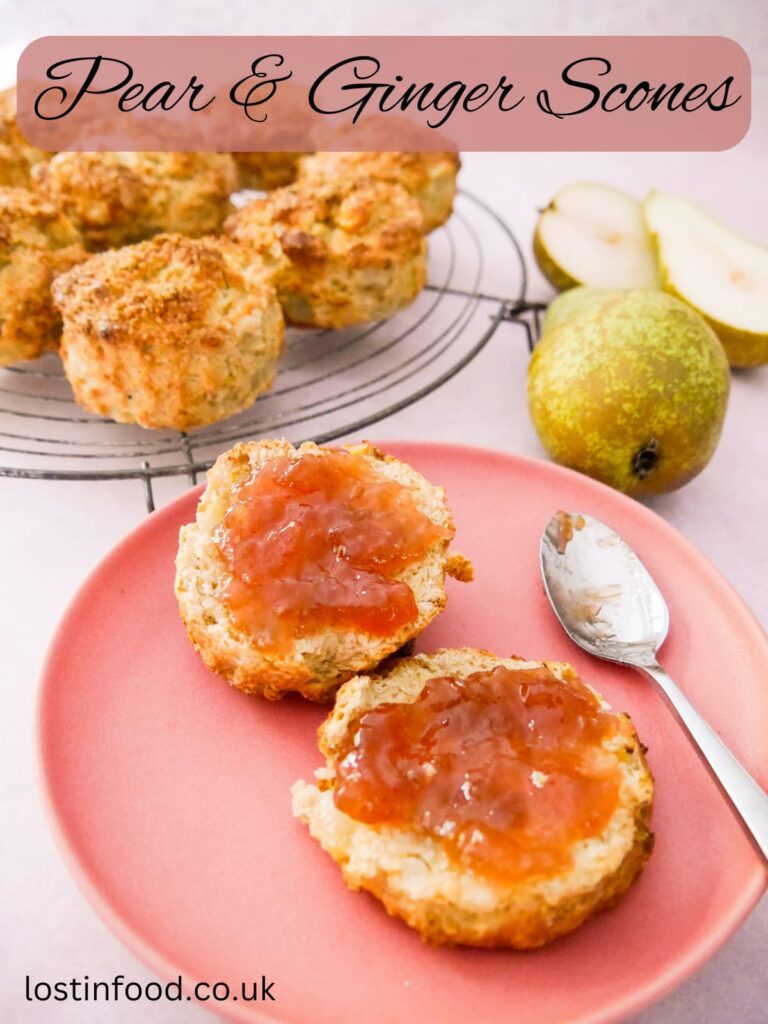
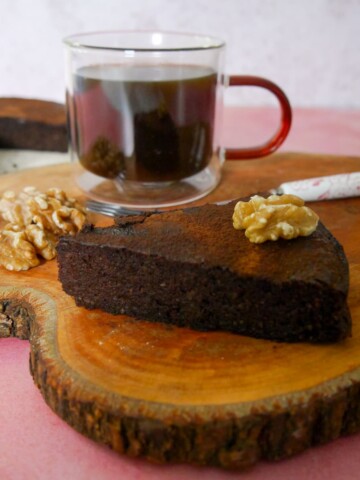
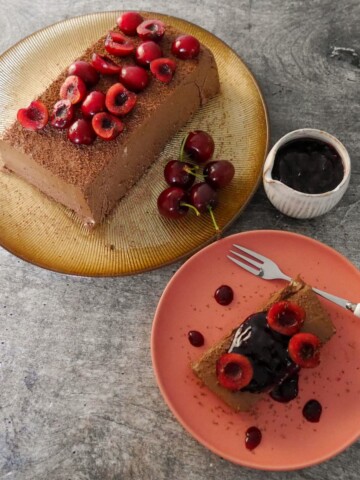
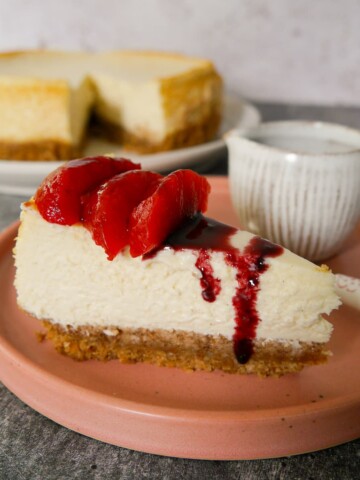
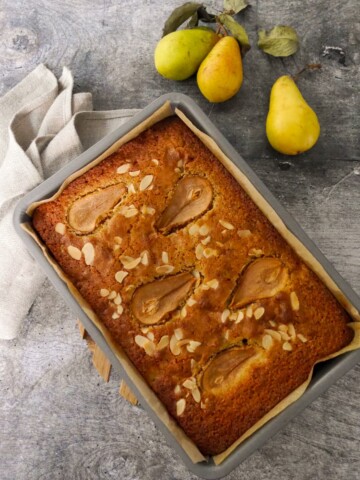
Francis says
Cracking flavour combination, these were a delight!
Lesley says
Thank you Francis, this is easily one of my favourite scone recipes.
Chloe says
I was very nervous putting raw fresh fruit into a scone but I was amazed at the texture and how well they cooked!
Lesley says
The pear is really great in this recipe and softens nicely without becoming soggy.
Janice says
I wasn't sure about fresh fruit in scones but I gave your recipe a try and it works so well. The pieces of juicy pear are lovely to bite into and the spices are the perfect complement.
Lesley says
Thank you Janice, I love adding fresh fruit to scones, you've just to be careful they're not overly ripe as you don't want them too juicy.